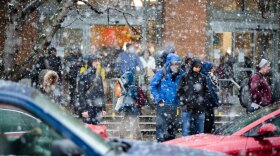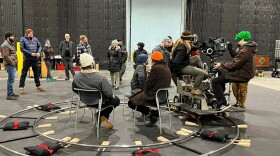BELLEVUE, Wash. — The busy intersection of Bellevue Way NE and NE 4th Street in Downtown Bellevue is surrounded by skyscrapers, retail shops and a park. But before the development, in the 1920s, the area was farmland run predominately by people of Japanese descent.
An oral history nonprofit called Densho has collected some of the voices of the individuals who lived in Bellevue during that time. One of those voices is from Mitsuko Hashiguchi, who lived on a farm here.
"In the summer months it was a beautiful farm," she said in a recorded interview. "I don't know — They all learned to raise lots and lots of strawberries. It was a strawberry area because of the soil that we had that was a strawberry field. The greater percentage was strawberries that we planted."
Before World War II, there were 300 Japanese Americans living in Bellevue, according to the Eastside Heritage Center. They made up 90% of the agricultural workforce. By the 1930s, not only were the farmers growing strawberries, but they were also growing and shipping peas and other produce all over the Northwest.
Then, the bombing of Pearl Harbor happened on Dec. 7, 1941. A few months later, on Feb. 19, 1942, President Franklin Delano Roosevelt issued Executive Order 9066, which led to the establishment of internment camps for people of Japanese descent who lived on the West Coast.
This is now known as The Day of Remembrance.

The City of Bellevue is displaying a large art installation at the King County Library System's Bellevue branch that shares stories from some of those who were incarcerated. It's in the form of a 10-foot wide and 13-foot tall farmhouse that features an off-centered roof and no door.
The artist who created this is Michelle Kumata.
"When you see the farmhouse, you notice there's something that's a little bit off," she said. "That's kind of like the tensions of all the stories being held inside, too. That there's a hint about something but it's not clear what it is."
The piece is titled Emerging Radiance and it's painted with bright green vines propping up red strawberries against a dark blue night sky. Portraits of nine farmers who were taken from their homes in the 1940s are painted on the walls. All of their stories were collected by Densho before they died.
Kumata said their skin tones are yellow and gold to represent the racism they've faced, but also to honor them.
"And then again, how we can take that back and own it — own our yellowness — and how important that is for us to be proud of who we are and proud to be different," Kumata said.
Kumata painted symbols on each person's clothing that represents their stories. For example, one person has a postage stamp painted on their shirt because they worked as a postal worker. Another has a Purple Heart to represent their military service.
Produce like a strawberry and a radish are also painted to look like stars in the night sky.

There are QR codes on the farmhouse, and when someone points the camera on their phone at them the portraits come to life. One of them represents Rae Matsuoka Takekawa, who describes FBI agents taking her father from their home the morning after Pearl Harbor.
"My mother is the one that I heard. I did not hear my father say anything," Takekawa said in the recording. "I will never forget her screaming and yelling at the authorities, and insisting on her rights. And all I knew was that he was gone."
Kumata collaborated with producer and director Tani Ikeda to create the augmented reality piece of the farmhouse. Ikeda also produced a documentary about the artwork.
Cranes — which symbolize longevity, peace, hope and healing — appear throughout the farmhouse, and guide people using the augmented reality feature from one wall panel to the next.
The City of Bellevue bought the farmhouse from the artists for its collection. It will be on display at the library until at least 2027.
Lorie Hoffman, the city's arts and creative economy manager, said putting this piece of art in an accessible place points back to the city's motto that states: "Bellevue welcomes the world. Our diversity is our strength."
"It is our true lived history here in Bellevue," Hoffman said. "Emerging Radiance shows us that acknowledging our past has such a wonderful opportunity to strengthen our future. We cannot shy away from the stories that are true and that are part of us."
Kumata said this history is especially relevant today. President Donald Trump has signed a slew of executive orders that relate to immigration, including one that seeks to end birthright citizenship. This constitutional amendment was used in the 1920s by first generation Japanese immigrants, who passed ownership of their land to their U.S. born children.

Kumata said what Japanese Americans experienced 83 years ago has parallels to what's happening today.
"We, as Japanese Americans, have a responsibility to share what happened to our community," she said. "And work to prevent this from happening to any other communities. It's really, really crucial right now."







